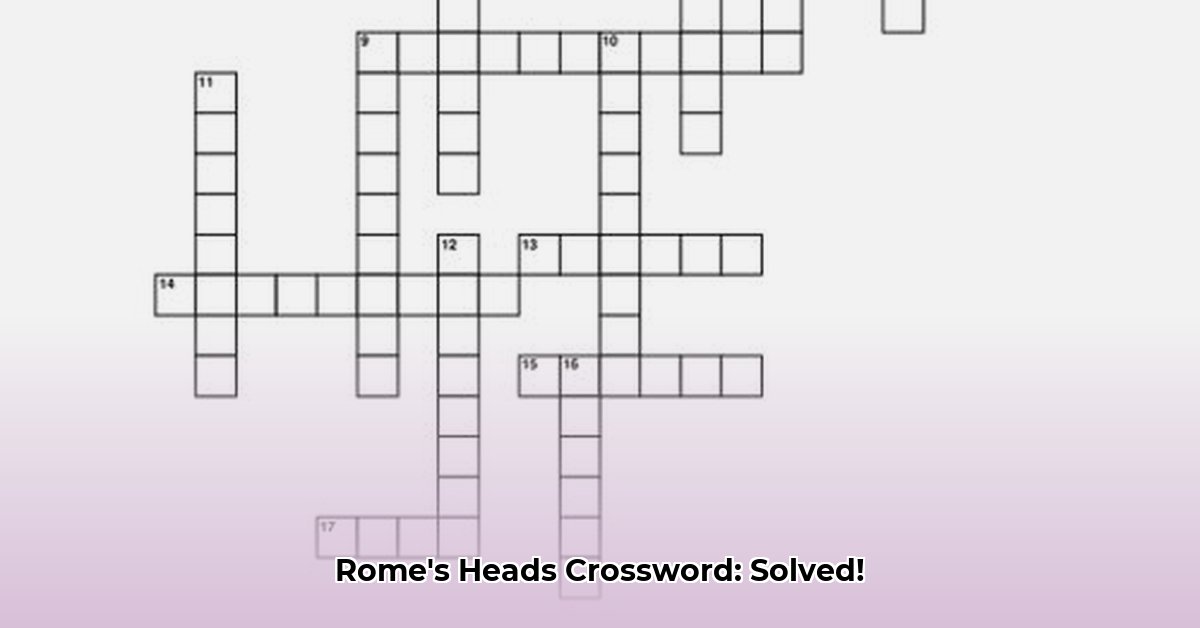The New York Times crossword often presents a delightful challenge, intertwining historical knowledge with linguistic cleverness. One such clue that frequently appears, causing many a puzzler to furrow their brow in contemplation, is “Heads of Ancient Rome.” You can explore more about the heads of Rome with guides dedicated to understanding the clue. While seemingly straightforward, these clues are designed to test not only your vocabulary but also your grasp of historical nuance and crossword setter psychology. This comprehensive guide will dissect the most common and definitive answer, “CAPITA,” explore a rich array of alternative Roman figures and concepts that could fit the bill, and arm you with the strategic insights needed to conquer this clue and similar historical puzzles every time.
The Prima Facie Answer: Why ‘CAPITA’ is King
When the “Heads of Ancient Rome” clue appears, your primary instinct should direct you straight to one powerful, six-letter Latin word: “CAPITA.” This answer reigns supreme in many crossword puzzles, thanks to its direct etymological link and the elegant simplicity it offers to puzzle constructors.
Unpacking the Etymology: The Meaning of ‘CAPITA’
“Capita” is the plural form of the Latin noun “caput,” which unequivocally means “head.” Therefore, a direct translation of “heads” from Latin provides “capita.” Crossword setters frequently leverage such direct linguistic translations, especially from classical languages, to create clues that are both accurate and subtly challenging. This directness makes “CAPITA” a highly favored solution for its unambiguous fit with the clue’s literal meaning. It’s a linguistic cornerstone for understanding Roman administrative and societal structures, often referring to individuals or populations in a numerical sense, counting them “by heads.”
Beyond the Obvious: Exploring Other Roman ‘Heads’
While “CAPITA” is the most probable answer, astute crossword solvers understand that variation is the spice of the puzzle world. The “Heads of Ancient Rome” clue could, depending on letter count and surrounding context, point to a myriad of other influential figures or concepts from Roman history. Understanding these alternatives enhances your historical knowledge and your crossword prowess.
Political and Imperial ‘Heads’
Ancient Rome transitioned through distinct political eras, each with its own “heads”:
- Consuls: During the Roman Republic (509 BC to 27 BC), the highest elected office was held by two Consuls. These individuals served as the chief magistrates, military commanders, and legislative leaders. Their annual election and shared power aimed to prevent tyranny. If a clue hints at the Republican era or requires a specific individual’s name (e.g., CATO, CICERO), Consuls might be the intended answer. The term ‘CONSULS’ itself, if the letter count allows, is a strong candidate.
- Emperors: With the dawn of the Roman Empire (27 BC to AD 476 in the West), Emperors became the supreme “heads” of the Roman state. Figures like AUGUSTUS, the first emperor who consolidated power and ushered in the Pax Romana, or later emperors such as NERO, HADRIAN, or MARCUS (referring to Marcus Aurelius), each held absolute authority. Their names, if fitting the letter count, are prime candidates for clues seeking specific “heads.” For example, a six-letter answer might hint at a common Roman name like “CAESAR” (though more a title later than a name), or “NERO.”
- Dictators: In times of extreme crisis during the Republic, a Dictator could be appointed for a limited term, wielding absolute power to resolve the emergency. While temporary, figures like CINCINNATUS embodied this “headship” in their brief, decisive reigns.
Military and Figurative ‘Heads’
Beyond explicit political roles, the concept of “heads” in Rome also extended to military command and even symbolic representations:
- Generals: The success and expansion of Rome were often driven by brilliant Generals. Legendary figures like JULIUS CAESAR, SCIPIO (Africanus), or POMPEY were often the de facto “heads” of Roman military and political strategy, leading legions and often shaping destiny. Their individual names could be answers if specific.
- Janus: This unique two-faced Roman deity of beginnings, gates, transitions, time, duality, doorways, and endings offers a fascinating, literal interpretation of “heads.” If the clue uses a more playful or mythological tone, JANUS could be the clever answer, playing on the idea of multiple faces or aspects.
- Busts: From an artistic perspective, a “head” can refer to a sculpted Bust—a representation of the head and shoulders of a person. Ancient Rome was renowned for its realistic portrait busts of emperors, senators, and citizens. If the clue implies sculpture, art, or effigies, ‘BUSTS’ might be the unexpected solution.
- Capitoline: Referring to the Capitoline Hill in Rome, this term, derived from “caput,” signified the symbolic and religious “head” of the city. As the site of major temples including the Temple of Jupiter Optimus Maximus, it was the spiritual and political heart of Rome. While unlikely for a direct “heads” clue, understanding its origin reinforces the importance of “caput.”
Mastering the Crossword Labyrinth: Strategies for Roman Clues
Crossword setters are masters of misdirection, wordplay, and subtle hints. Tackling clues like “Heads of Ancient Rome” requires more than just historical knowledge; it demands a strategic approach to puzzle-solving.
Here’s a refined framework for conquering historical and Latin-based crossword clues:
- Strict Letter Count Adherence: This is your primary filter. Before anything else, count the empty squares. An answer like “AUGUSTUS” (8 letters) will never fit a six-letter slot. Conversely, if you have six letters, ‘CAPITA’ becomes a highly probable candidate immediately. This simple step eliminates countless incorrect possibilities.
- Contextual Clue Analysis: Examine the surrounding clues and the puzzle’s overall theme. Is the crossword focusing on mythology, history, famous figures, or Latin phrases? Sometimes, other clues can subtly signal a specific period (e.g., clues related to the Republic might narrow “heads” to Consuls rather than Emperors).
- Leverage Intersecting Letters: As you solve other parts of the grid, fill in any crossing letters. These confirmed letters are invaluable. They can reveal patterns, confirm guesses, or decisively rule out possibilities for your tricky Roman clue. For instance, if you have “_A_IT_A,” your confidence in “CAPITA” should soar.
- Embrace Synonyms and Wordplay: Crossword setters love to use synonyms, homophones, or puns. “Heads” might not always refer to leaders; it could imply “origins,” “directions,” or “main parts.” For example, a clue hinting at “Capital of ancient Rome” could be “ROME” (if the letter count matches) or even “CAPUT” in a specific context.
- Consider Latin Roots and Phrases: Many English words have Latin origins. Crossword clues often play on this. Understanding common Latin terms or roots (like caput, urbs, pater) can unlock answers that seem opaque at first glance. Be alert for clues that subtly suggest a Latin answer.
- Recognize Setter Tricks:
- Abbreviations: Sometimes, a common historical figure might be clued by an abbreviation (e.g., “Julius” for “Caesar” is unlikely unless the letter count indicates a shorter form).
- Specific Dates/Events: If the clue mentions a specific year or battle, it narrows the period and thus the potential “heads.”
- Punny Clues: “Heads” can be literal (body parts, leaders) or figurative (main ideas, directions). The presence of a question mark often signals a pun or wordplay.
- Strategic Use of Resources: If you’re truly stumped, a targeted online search for “Heads of Ancient Rome crossword clue” will often lead you to the most common answers. Utilize comprehensive crossword solvers, but always try to understand why the answer fits to improve your future solving skills.
Conclusion: Conquering Roman Crosswords
The journey to mastering the “Heads of Ancient Rome” crossword clue, and indeed all historical or Latin-based puzzles, is one of informed deduction. While “CAPITA” stands as the perennial go-to answer for its direct Latin translation, the nuanced world of Roman history offers a captivating array of alternative “heads” from Consuls and Emperors to Generals and even mythical deities like Janus. By combining a solid grasp of historical context with keen observation of letter counts, intersecting clues, and the subtle art of crossword constructor psychology, you can confidently decode even the most challenging NYT crossword clues. Sharpen your pencil, apply these strategies, and let the satisfaction of a completed grid be your victory march!
Key Takeaways for Crossword Success:
- “CAPITA” is the most frequent and direct answer for “Heads of Ancient Rome,” deriving from the Latin word for “heads.”
- Context is paramount: The specific era (Republic vs. Empire) or type of “head” (political, military, symbolic) can dictate alternative answers like Consuls, Emperors, or Generals.
- Strategic puzzle-solving involves rigorous letter counting, utilizing intersecting clues, understanding Latin roots, and recognizing common crossword setter techniques.
- Expand your historical vocabulary: Familiarity with key Roman figures and concepts significantly boosts your ability to tackle these clues.
- Practice and perseverance are critical for developing the intuition needed to solve complex historical and linguistic crosswords.
[Citation: https://nytcrosswordanswers.org/heads-of-ancient-rome-crossword-clue/]










